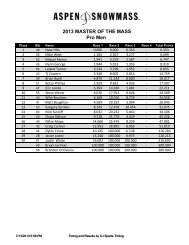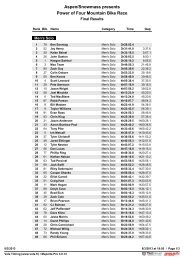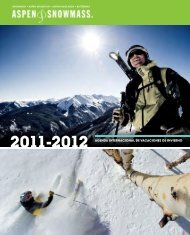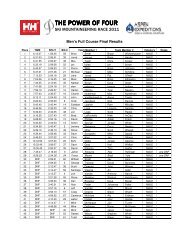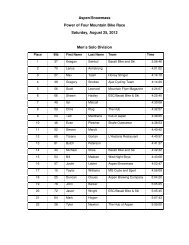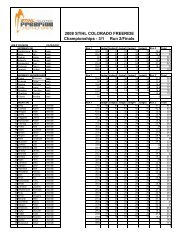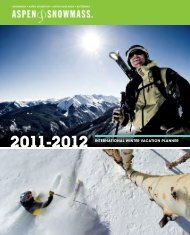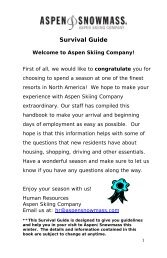LEED is Broken - Aspen/Snowmass
LEED is Broken - Aspen/Snowmass
LEED is Broken - Aspen/Snowmass
Create successful ePaper yourself
Turn your PDF publications into a flip-book with our unique Google optimized e-Paper software.
easier to burn down a barn that to build one, and we wrote th<strong>is</strong> paper reluctantly, but with<br />
the hope a frank d<strong>is</strong>cussion will help <strong>LEED</strong>, the green building movement, and the<br />
planet. For that d<strong>is</strong>cussion to prosper, let’s check our emotions at the door. An informal<br />
survey of <strong>LEED</strong> critics suggests that the U.S. Green Building Council has been less than<br />
receptive to critic<strong>is</strong>m. Some authors have been greeted with rage from <strong>LEED</strong> proponents,<br />
which only emphasizes the program’s near cult-like nature. What’s needed <strong>is</strong> a rational<br />
d<strong>is</strong>cussion, not a war.<br />
Finally, our proposals for reform are incomplete. Others are encouraged to weigh in on<br />
what’s right and wrong. Throughout th<strong>is</strong> paper, we’ve referenced some of the excellent<br />
research that has been done so far.<br />
Problem # 1: <strong>LEED</strong> Costs Too Much<br />
An avalanche of reports ins<strong>is</strong>t that green building—and <strong>LEED</strong> certification in<br />
particular—doesn’t cost more than conventional building. These reports are wrong. The<br />
second you start a green building project, it costs more than conventional construction.<br />
But the word on the street still seems to be that <strong>LEED</strong> <strong>is</strong> cheap, and green building pays<br />
for itself. Last summer, for example, a report compared the costs of <strong>LEED</strong> and non-<br />
<strong>LEED</strong> buildings and found “no stat<strong>is</strong>tically significant difference.” 12 It <strong>is</strong> true that other<br />
factors have more influence on building cost than whether one chooses to pursue <strong>LEED</strong>.<br />
But the fact remains that <strong>LEED</strong> certification costs extra.<br />
Too many consultants, think tanks, and architects are pitching th<strong>is</strong> “no-pain, no pain” line<br />
to sell their services. Some of the studies they cite are remin<strong>is</strong>cent of the Bush<br />
Admin<strong>is</strong>tration’s “sound-science,” “Healthy Forests,” and “Clear Skies” initiatives.<br />
For example, a well-publicized study done for the U.S. General Services Admin<strong>is</strong>tration<br />
(which requires <strong>LEED</strong> certification for its new buildings) failed to account for the costs<br />
associated with comm<strong>is</strong>sioning, which <strong>is</strong> a <strong>LEED</strong> prerequ<strong>is</strong>ite. That’s like getting a new<br />
car price quote without the engine. (Th<strong>is</strong> study also didn’t account for the cost of<br />
obtaining three other expensive credits, d<strong>is</strong>counted because they were already required by<br />
the GSA.) In the real world, <strong>LEED</strong> certification typically adds 1% to 5% to the budget. A<br />
nonprofit group in our valley recently figured their added costs at $50,000 to certify a<br />
10,000 square foot building.<br />
The myth that going green costs nothing <strong>is</strong> damaging to clients who d<strong>is</strong>cover the reality<br />
deep in the process. Instead of using fuzzy math to show that green building doesn’t add<br />
costs, let’s acknowledge that these buildings cost more and are worth it. There are many<br />
reasons for added expense. First, green building <strong>is</strong> a deviation from business as usual.<br />
When you ask a builder to modify h<strong>is</strong> tried-and-true, or ask an architect to design past<br />
code, you are mounting an expedition into a thorny new landscape, requiring extra<br />
meetings, added design time, and inevitably, the m<strong>is</strong>takes and backtracking that come<br />
12 L. F. Matthiessen and P. Mor<strong>is</strong>. 2004. “Costing Green: A Comprehensive Cost Database and Budgeting<br />
Methodology.” Publ<strong>is</strong>hed by Dav<strong>is</strong> Langedon Adamson. Available online at<br />
http://www.dladamson.com/Attachment%20Files/Research/costinggreen.pdf<br />
5



